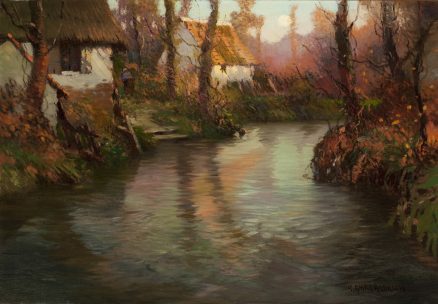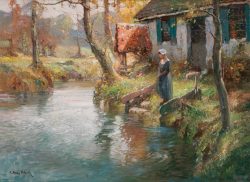- Categories
- Landscapes
- Zoom in on Artwork
- Print Page
- Email Page to Friend
Now called Normandie Sunset, this painting by George Ames Aldrich applies his favorite compositional formula—high horizon and dominant broad expanse of water—to a recurrent subject: rural structures clustered on the banks of a swift stream. Here, the unseen setting sun scatters tints of pink throughout the scene as the moon rises in a clear sky still pale with daylight; a woman glimpsed retreating down the path away from the stream bank adds a further note of lingering farewell. The white stucco walls and red clay-tile roofs of the cottages link this work to the artist’s many depictions of Brittany and Normandy villages, typically shown at sunset or in moonlight and often cloaked in snow. Finding them popular with his Chicago-area and Indiana patrons, Aldrich continued to produce such works long after he first painted in France at the turn of the twentieth century. He was inspired not only by the tumbledown picturesque qualities of the actual settings but also by the paintings of Norwegian landscape painter Fritz Thaulow. Although Aldrich probably was not a pupil of Thaulow as he claimed, he certainly admired, studied, and emulated his work, notably Thaulow’s treatment of flowing water and of snow. In this example, Aldrich lavished particular attention on the stream’s broken but still reflective surface, while painting the surrounding scenery more rapidly with broader brushstrokes.
In the late 1910s and 1920s, the period to which this canvas likely dates, Aldrich was among many Chicago-area landscape painters who combined the open brushwork, bright hues, and tactile surface effects of impressionism with a decorative sensibility. Here the artist created a romantic, pleasantly melancholic mood by deliberately manipulating viewpoint, light, and color, combining sunset light, a rising full moon, and moody shadows that lend tonal unity to the composition. In Aldrich’s day, the evocation of an artist’s personal emotional response to the landscape was often cited by sympathetic reviewers as a measure of aesthetic value. The traditional European setting served as Aldrich’s vehicle for the elegiac sentiment that intensified in the World War I period, when the closing of access to Europe seemed to mark the dissolution of the very traditions that had long drawn Americans there. Aldrich’s lifelong artistic investment in the French landscape and in rural village life embodied nostalgic retrospection in an era of dizzyingly rapid change.
Wendy Greenhouse, PhD
Donated by M. Christine Schwartz to the South Bend Art Museum, South Bend, Indiana, in 2021

